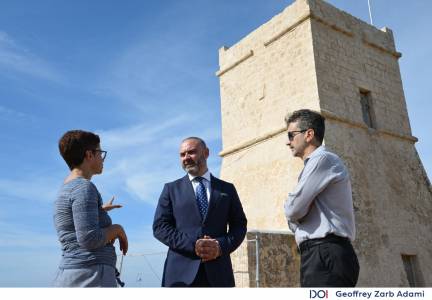The consolidation and restoration work on the Għajn Tuffieħa Tower by the Department of Restoration and Preservation has been completed.
The Tower, built in 1637, was one of a series of coastal towers built during the time of Grand Master Lascaris with the aim of strengthening the Maltese coastal defence against pirate invasions.
Minister for Culture, Lands and Local Government Owen Bonnici said, “The protection of our historical heritage remains a priority for this Government. The Għajn Tuffieħa Tower is not only a testament to our country’s defensive history, but it is also one of the symbols of our coastal identity. Thanks to the interventions carried out by the Department of Restoration and Preservation, we are ensuring that this tower will remain standing for future generations, in a safe and dignified condition. This project reflects our ongoing commitment to protecting and renewing sites that embody Malta’s collective memory.”
He also thanked the Lands Authority staff for their full cooperation throughout the entire work process and in the previous months. The Għajn Tuffieħa Tower suffered extensive damage in 2023, following continuous rain and strong winds caused by Cyclone Helios. As a result, the building suffered extensive damage which led to the collapse of the central section of the upper part of the facade facing south-west.
The Lands Authority intervened immediately by erecting scaffolding around the tower in order to support it and thus prevent further collapse. Following the approval of the necessary permits by the Planning Authority, in May 2025 the Department of Restoration and Preservation commenced essential repair works to address the structural damage.
The scope of the project was then extended to include additional interventions deemed necessary in order to prevent further damage to the building. Today, these interventions have come to a successful conclusion. The project included the reconstruction of the collapsed part, the removal or replacement of iron elements that had corroded and were damaging the surrounding stonework, the insertion of gutters to divert rainwater away from the structure and the plastering of exposed wires.
Photo: DOI
![]()








